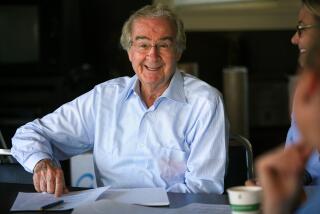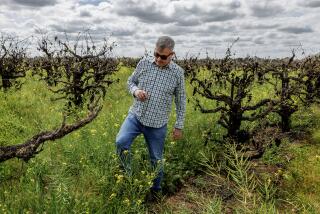BROTHERS AND VINTNERS : Sam and Don Sebastiani Each Uncork Premium Wines
SONOMA, Calif. — Sam Sebastiani turned as he unlocked a shed down the hill from his Eagle Ridge Ranch home above town. The shed houses a tiny winery in which he intends to craft special wines in batches of 400 cases.
“I call it Villa Vittoria --victory!” he said, pushing open the door.
For now, Villa Vittoria is Sebastiani’s only wine-making facility. But the new Sam J. Sebastiani Winery--founded by Sam and his wife, Vicki, in the wake of his firing, by his mother, as president of the family’s Sebastiani Vineyards--is already producing limited editions of premium wines made under contract by two Napa Valley wineries.
The new winery’s headquarters are in Sonoma, at the opposite end of town from Sebastiani Vineyards. Wine country visitors are unlikely to miss that ivy-covered edifice with its well-appointed tasting-sales room and the towering, carved aging tanks it contains.
Established in 1904 by Sam Sebastiani’s grandfather and namesake, Samuele, and now the nation’s eighth-largest winery, Sebastiani Vineyards flanks the last of the chain of missions established by Father Junipero Serra.
On the other hand, visitors would have a hard time finding Sam J. Sebastiani Winery, established in 1986. There are no tours and no ivy. Just a suite of offices in a nondescript professional building. And the bitter legacy that lead to its founding.
Sam and Vicki Sebastiani financed their enterprise by selling the old Sebastiani Building facing the town plaza, which 46-year-old Sam had inherited in 1944 from his grandfather. Sam also cashed in the pension that he had earned during 20 years at the family winery and from which, as he unceremoniously put it recently, he was “booted out” last year after six years as president.
Rather than linger over his painful firing by Sylvia Sebastiani and his replacement by 34-year-old brother Don, the former Republican assemblyman, Sam decided to pour everything he had learned about wine and all he knew about business (he has a master’s degree from the University of Santa Clara) into a new venture.
The publicity surrounding the ouster was clearly wounding, but as a businessman Sebastiani recognized that he could capitalize on public interest and quickly launched his own winery. His idea was to produce small quantities, just 8,000 cases initially, of three premium wines that he hoped would contain the best that Sonoma County and Napa Valley grapes could offer.
“When you make wine, you have to conceive of style,” Sebastiani explained. “After all, California doesn’t need another winery.” His challenge is to distinguish Sam J. Sebastiani Winery from the state’s other 650 wineries--and certainly from Sebastiani Vineyards.
“We came up with the idea of blending Napa and Sonoma grapes together, with Napa grapes providing the wine’s backbone and intensity and Sonoma’s the floral qualities to the nose, and we have tried to find vineyards that meet this profile,” he said. The fruit comes from six selected vineyards in Sonoma County and four in adjacent Napa Valley, each chosen to contribute specific flavor or textural elements.
First Releases Acclaimed
Sebastiani’s marketing hunch proved correct: The first offerings from these vineyards--a 1985 Chardonnay, a 1985 Sauvignon Blanc and a 1983 Cabernet Sauvignon--quickly won distribution in 32 states and the District of Columbia. Some even was shipped to Britain, France and Taiwan.
The wines also drew praise from writers who had witnessed Sebastiani’s unexpected fall from family grace, on New Year’s Day, 1986, just as he appeared to have not only turned around a seriously troubled business but also succeeded in changing its image as principally a jug wine operation to a premium winery.
The trouble began a few years after the greatest coup by Sam and Don’s father, August, who began putting the family name on the wines that had before been produced to wear other wineries’ labels: bottling varietal wines in 1.5-liter magnums and even larger bottles normally used for only the cheapest generic wines.
As a result, Sebastiani Vineyards’ production doubled, tripled and quadrupled in the 1970s to a peak of nearly 4 million cases. But what August Sebastiani refused to do, in the view of his eldest son who worked beside him at the time, was to make the investments in equipment and staff needed to maintain quality through the rapid expansion.
The strain showed in 1978 when Brettanomyces bacteria, a wild yeast infection, broke out at the winery. “Bottles began exploding in the stores,” Sam Sebastiani said. Eradication included the recall and destruction of nearly $1 million in defective wine--and, he claimed, the near destruction of the winery’s reputation as a producer of dependable, if not distinguished, wines.
‘Giants’ Battle
By his father’s death in 1980, jug wine sales were falling nationally and competition had quickened with Coca-Cola’s purchase of Taylor California Cellars and its unprecedented advertising campaign comparing its wine with that of competitors, including Sebastiani Vineyards.
“I called it the battle of the giants,” Sebastiani said, and he concluded that even a large family winery could not compete. (Eventually, Coca-Cola sold its wine holdings.) The future, he decided, lay in the higher-margin, premium wine market.
To reposition the family winery required the substantial investment in equipment and people that his father had refused to make--$6.5 million in all--and replacement of the faltering “Mountain” wines with slightly more upscale “Country” varietals bottled in more elegant Bordeaux-style, long-necked magnums.
“This business was dying,” he said. “The whole brand was dying.”
To dramatize the break with the jug wine past, Sebastiani also recalled $2 million of Mountain wines that he considered no longer worthy of the repositioned Sebastiani Vineyards. And he and his new wife, Vicki, (they were married, both for the second time, in 1979) undertook a whirlwind campaign of personal appearances and high-profile promotions to re-establish Sebastiani’s presence on distributors’ lists and retailers’ shelves.
Production of the new line of Country wines, introduced in 1982, grew from 300,000 cases to 1.2 million cases by the time that the heavy investments, lagging sales and several years of losses began to worry Sylvia Sebastiani, who had inherited August’s 90% stake in the winery.
Decreasing Losses
Meanwhile, Don had given up the Assembly seat he had held since 1980, representing much of the Sonoma wine country, in an unsuccessful bid for the Republican nomination as state controller.
While the matriarch has yet to give her reasons for her action, most accounts attribute it to her belief that her elder son’s spending had threatened the winery’s future. By 1984, he acknowledged, the loss approached $2 million, but it shrunk in 1985 to $500,000, he said, and a $2-million profit was projected for 1986.
“What really hurt was to be called a failure,” he said.
In any case, the mother resigned as chairman and named Don Sebastiani, freshly returned from Sacramento, new chairman and chief executive. And under his direction, the winery is again pushing production beyond 3 million cases, up 22.4% in a year, with most of the growth still coming from the Country varietals.
But far from phasing out these Country wines, Sebastiani startled Sonomans in August by announcing that the winery would move production out of Sonoma County and east to Lodi in the upper San Joaquin Valley, closer to the lower-priced grapes from which they are made. The news culminated a 10-year community battle growing out of the winery’s rapid expansion and the noise and heavy truck traffic that came with it.
Many residents assumed that the bulk wine business would merely move to a more rural site and keep the jobs in Sonoma County. Instead, 100 of the winery’s present 180 year-round jobs will leave this city of 7,075.
The final decision to move, expected in December, depends only on wine-making tests under way at the 12.5-acre facility near Lodi, Don Sebastiani said in an interview.
But his aim, which differs from the more focused marketing strategy favored by his brother, is to show that a family-owned winery can indeed compete successfully with whomever and at all levels of the market.
Only Napa Valley’s Robert Mondavi Winery (coincidentally founded 21 years ago after a rift in the Mondavi family, owner of Charles Krug) has so far succeeded in spreading its label over such a broad spectrum of wines without suffering an identity crisis. And Robert Mondavi’s low-end varietals--the so-called Bob White and Bob Red--are produced near the San Joaquin Valley winery that Sebastiani has optioned.
To underscore his intent to redouble his brother’s earlier efforts at strengthening the family’s top-of-the-line offerings, Don Sebastiani last July formed the Estates Group in New York City to create and market only top-of-the-line varietals on which the names of the Sonoma County vineyards that produced the grapes will have top billing on the label over Sebastiani.
Due Next Year
“At the upper end, we intend to compete with the best,” he said.
The initial release, due next year, will consist of four different vineyard-designated Chardonnays and two Cabernet Sauvignons. In a statement announcing the new venture, Sebastiani went out of his way to credit “the foresight, leadership and success of my predecessors--my grandfather, Samuele; my dad, August, and my brother, Sam.”
Sam Sebastiani said he wishes his brother well. After all, he stands to inherit one-third of the winery some day. (There is a sister, Mary Ann Cuneo.)
But he and Vicki have plans of their own: From the modest beginning with Villa Vittoria, California Bonded Winery No. 5374, the couple intends to expand in the next five years to a gracious new winery to be built in the style of North Italian villas. The buildings will be grouped around a piazza , recalling something of the land that Grandfather Samuele left in 1895 to make a new life for his family in California.
“If I haven’t created the most interesting winery facility in Sonoma,” the grandson said, “then I’ll have pretty much wasted my time.”
More to Read
Eat your way across L.A.
Get our weekly Tasting Notes newsletter for reviews, news and more.
You may occasionally receive promotional content from the Los Angeles Times.










